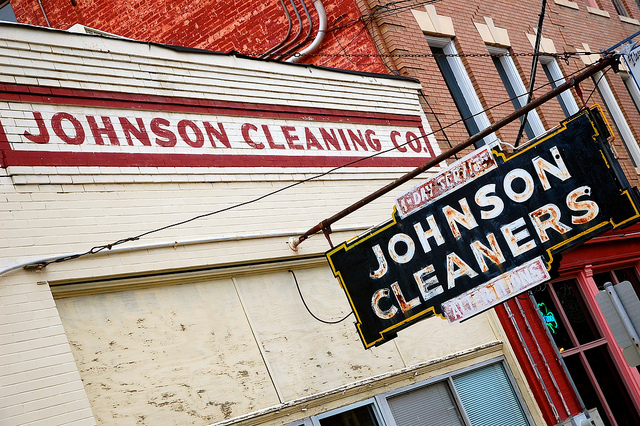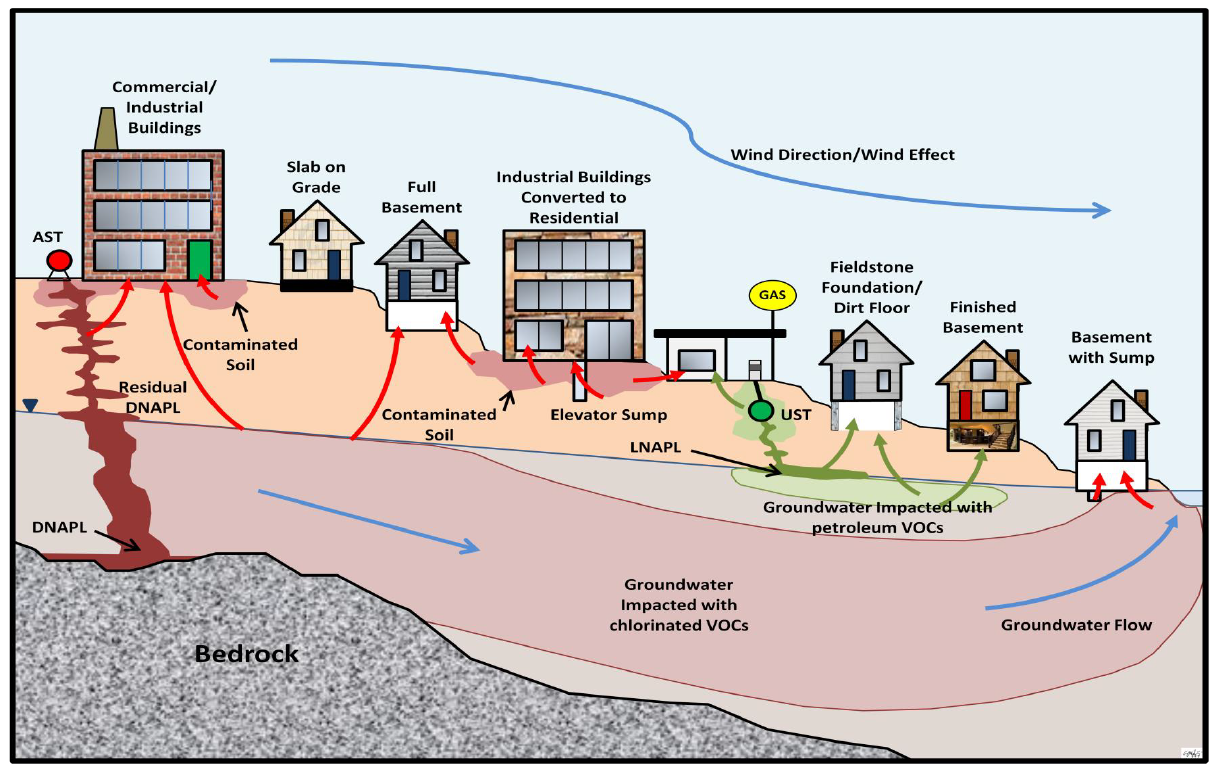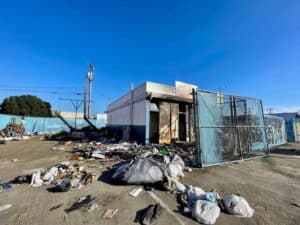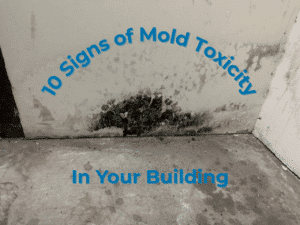Vapor Intrusion: A Hidden Risk for New Construction and Redevelopment

Development stakeholders have an array of risks to consider when constructing any new property or redeveloping existing properties: placement of utility lines, safety compliance, and the storage of hazardous materials, for example. But there is an invisible risk beneath a property’s surface that could degrade the quality of your building, property and indoor environment before it’s even finished: vapor intrusion.
Vapor intrusion occurs when there is a migration of volatile organic compounds (VOCs) or chemicals from a subsurface source (i.e., contaminated groundwater or soil) into an overlying building’s indoor air. Vapors in soil gas enter buildings through:
- Cracks in the foundation
- Openings for utility lines, plumbing and other conduits, such as electrical outlets
Examples of volatile and semi-volatile chemicals include de-greasers, dry-cleaning solvents, gasoline and petroleum (including benzene, toluene, ethylbenzene and xylene), naphthalene, polychlorinated biphenyls (PCBs), and certain pesticides. In late 2016, the U.S. Environmental Protection Agency (EPA) began risk evaluation of many chemicals associated with vapor intrusion.
In extreme cases, the vapors may accumulate into dwellings or occupied commercial and industrial buildings to airborne concentrations that may pose:
- Near-term safety hazards (e.g. explosion)
- Acute and adverse health effects
Why You May Need a Vapor Intrusion Assessment
A site assessment is needed to determine the level of risk intrusive vapors pose to your building occupants. While it can create serious health risks, vapor intrusion often goes unnoticed by building occupants.
In buildings with lower concentrations of vapor-forming chemicals arising from vapor intrusion, the main concern is whether the chemicals may pose an unacceptable risk of health effects to occupants due to long-term (i.e. chronic) exposure.
So how do you know if your property or development is at risk from vapor intrusion? According to the EPA, vapor intrusion is a potential concern at any building, existing or planned, located near soil or groundwater that is contaminated with VOCs. This includes contaminated sites within the near vicinity of your property. Commercial and industrial area sites most commonly contaminated with VOCs are those that include or have historically included:
- Manufacturing plants
- Chemical processing plants
- Landfills
- Warehouses
- Train yards
- Dry cleaners
- Gas stations
- Coal gasification plants
- Printers
- Automobile repair shops
- Any site where USTs (underground storage tanks) are leaking
 Courtesy of MASSDep – This illustration portrays the potential for vapor intrusion on different types of properties.
Courtesy of MASSDep – This illustration portrays the potential for vapor intrusion on different types of properties.
Developers and property owners should also keep in mind that vacant properties may contain VOC contamination. As you can see in the illustration above, wind effects, groundwater flow, and stack effects (pressure differences inside and outside a building caused by differences in indoor and outdoor temperatures) are all factors when assessing vapor intrusion.
If vapor intrusion is a concern on your property, the EPA recommends a risk assessment by qualified personnel to evaluate the degree of risk to future building occupants. If you are not sure based solely on the property’s location or current state whether a risk assessment should be conducted, it may be necessary to research the history of the property, surrounding properties, site geology and hydrogeology, among other site characteristics, before beginning sampling and analysis.
Sampling and Analysis of Vapor Intrusion
In the past, many environmental consultants and services providers did not account for potential vapor intrusion impacts in Phase 1 site assessments and vapor intrusion was believed to be an issue solely determined by indoor air sampling. Omega principals know from decades of experience that vapor intrusion is a holistic environmental issue requiring multiple lines of evidence to form the most accurate site characterization and determine the best steps for mitigation. The initial step in creating a vapor intrusion mitigation plan is forming a conceptual site model, but first, sampling and analysis will be necessary through a combination of the following methods:
- Characterize the nature and extent of subsurface vapor sources using:
- Indoor Air Sampling
- Sub-Slab Soil Gas Sampling
- Soil Gas Sampling
- Compare sample concentrations to health-based screening levels
- Conduct and interpret human health risk assessment: perform indoor air risk analysis (modeling indoor-air risks using modified Johnson and Ettinger model for soil-gas and groundwater) to evaluate the potential for vapor intrusion
- Evaluate the vapor intrusion modeling results to determine whether the concentrations of VOCs detected in the soil vapor samples at the site present any potential unacceptable health risks to the workers/tenants inside the building
For more information on vapor intrusion, read our whitepaper: Vapor Intrusion: How to Ensure Environmental Compliance
If you believe your property may be at risk for vapor intrusion or other subsurface contamination, Omega can help you characterize the issue and form a cost-effective mitigation plan.
The Omega team has deep experience in environmental assessment and mitigation designed to get your project back on track safely, cost-effectively and compliantly. Give us a call to learn how we can help you assess and manage the threat of vapor intrusion on your site.
Sources and Further Reading on Vapor Intrusion
- Brownfields Technology Primer: Vapor Intrusion Considerations for Redevelopment – EPA.gov
- A Stakeholder’s Guide to New Construction at Vapor Intrusion Sites – Center for Public Environmental Oversight, Lenny Siegel
- Vapor Intrusion: A Game Changer for Environmental Due Diligence and Environmental Liability – The Practical Real Estate Lawyer, Lawrence P. Schnapf
- How to Effectively Manage Vapor Intrusion Risks When Acquiring and Developing Property – Farella Braun and Martell LLP
Contact us for more information about Vapor Intrusion Assessment










